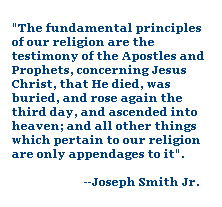"The Land Ordinance of 1785 finally implemented a standardized system of Federal land surveys that eased boundary conflicts. Using astronomical starting points, territory was divided into a 6-mile square called a township prior to settlement. The township was divided into 36 sections, each measuring 1 square mile or 640 acres each. Sale of public land was viewed as a means to generate revenue for the Government rather than as a way to encourage settlement. Initially, an individual was required to purchase a full section of land at the cost of $1 per acre for 640 acres. The investment needed to purchase these large plots and the massive amount of physical labor required to clear the land for agriculture were often insurmountable obstacles. By 1800, the minimum lot was halved to 320 acres, and settlers were allowed to pay in 4 installments, but prices remained fixed at $1.25 an acre until 1854."
To understand D&C 42:30 that required members with land to consecrate it to the bishop's storehouse you need to understand the Homestead Acts and Land Ordinance laws of the time. Prior to the civil war, if you were to purchase land from the federal government, you could only purchase it in huge alotments no less than 320 acres. Before the tractor, this plot of land was way too big for any one person to farm. The big plots of land did NOT favor settlement. So in the spirit of creating a city and settlement for the saints those saints who were awarded ajoining 320 or 640 acre land ordinances from the Federal Gov were commanded to consecrate the excess land to the Church for the purpose of making a settlement for all the saints who would be gathering to Zion.
This consecration of land was instead of having the few LDS land owners who had won the land grants from charging the church and the members perpetual rent to settle on the properties. Similarly, neither the Church nor the bank owned all the land. Each family was given an inheritance of land that they owned outright. The emphasis here should more be about individual property rights and not land redistribution.
The reason I point this out is because some look to D&C 42 to understand God's law of consecration and they interpret these verses in terms of socialist-style income redistribution. I think this is incorrect. The United Order recognized property rights, it satified both wants and needs, emphasized work and personal responsibility, fostered self-reliance, and was voluntary. I think when we see and practice the United Order it its true form and live with "all things common" (not "all things in common"), that we will all conclude, "why didn't we all do this earlier?"
Personal responsibility and self-reliance notwithstanding, we should not forget helping the poor and needy is still a sacred personal reaponsibility and part of true religion.













No comments:
Post a Comment